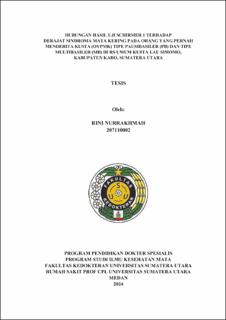| dc.contributor.advisor | Zubaidah, T Siti Harilza | |
| dc.contributor.advisor | Delfi | |
| dc.contributor.author | Nurrakhmah, Rini | |
| dc.date.accessioned | 2025-01-17T03:43:10Z | |
| dc.date.available | 2025-01-17T03:43:10Z | |
| dc.date.issued | 2024 | |
| dc.identifier.uri | https://repositori.usu.ac.id/handle/123456789/100259 | |
| dc.description.abstract | Background: Leprosy is a chronic, infectious, and contagious disease caused by Mycobacterium leprae. In leprosy patients, there is a decrease in tear production, which is a primary cause of dry eye syndrome (DES). The assessment of DES can be conducted using the Schirmer 1 test, which has not yet been performed to determine the degree of DES on persons affected by leprosy in North Sumatra.
Aim: To analyze the association between Schirmer 1 test results and the degree of DES in persons affected by leprosy with pauci-bacillary (PB) and multi-bacillary (MB) types
Methods: An analytical observational study with a cross-sectional approach used 41 persons affected by leprosy treated at Lau Simomo Leprosy General Hospital. Schirmer 1 test results were measured to evaluate tear production, while the degree of DES was assessed using Tear Break Up Time (TBUT).
Results: The characteristics of persons affected by leprosy patients showed a male predominance (56.1%) and an age category of 46-65 years (48.8%). Most patients were of the MB type with a treatment duration of 12 months (90.2%), and deformities were found in 18 patients (43.9%). Ocular involvement included cataracts (29,3%) and madarosis (4.9%). The majority of Schirmer 1 test results were > 10 mm (58.5%), with most patients had severe degree of TBUT (48.4%). Schirmer 1 test results < 5 mm correlated with 80% severe degree, while results of 5-10 mm showed 57.1% severe degree, and > 10 mm indicated 33.3% severe degree. A significant relationship was found between Schirmer 1 test results and the degree of DES based on TBUT assessment (p < 0.05).
Conclusion: The Schirmer 1 test can serve as a useful tool in assessing the severity of DES in persons affected by leprosy, particularly in the MB type. Persons affected by leprosy patients are advised to undergo regular eye examinations to prevent the progression of other ocular complications. | en_US |
| dc.language.iso | id | en_US |
| dc.publisher | Universitas Sumatera Utara | en_US |
| dc.subject | MB | en_US |
| dc.subject | PB | en_US |
| dc.subject | persons affected by leprosy | en_US |
| dc.subject | Schirmer 1 | en_US |
| dc.subject | TBUT | en_US |
| dc.title | Hubungan Hasil Uji Schirmer 1 terhadap Derajat Sindroma Mata Kering pada Orang yang Pernah Menderita Kusta (OYPMK) Tipe Pausibasiler (PB) dan Tipe Multibasiler (MB) di RS Umum Kusta Lau Simomo, Kabupaten Karo, Sumatera Utara | en_US |
| dc.title.alternative | The Association Between Schirmer 1 Test Results and the Degree of Dry Eye Syndrome in Persons Affected by Leprosy Paucibacillary (PB) and Multibacillary (MB) Types at Lau Simomo General Hospital, Karo District, North Sumatra | en_US |
| dc.type | Thesis | en_US |
| dc.identifier.nim | NIM207110002 | |
| dc.identifier.nidn | NIDN0022047604 | |
| dc.identifier.nidn | NIDN0022096703 | |
| dc.identifier.kodeprodi | KODEPRODI11773#Ilmu Kesehatan Mata | |
| dc.description.pages | 109 Pages | en_US |
| dc.description.type | Tesis Magister | en_US |
| dc.subject.sdgs | SDGs 3. Good Health And Well Being | en_US |


